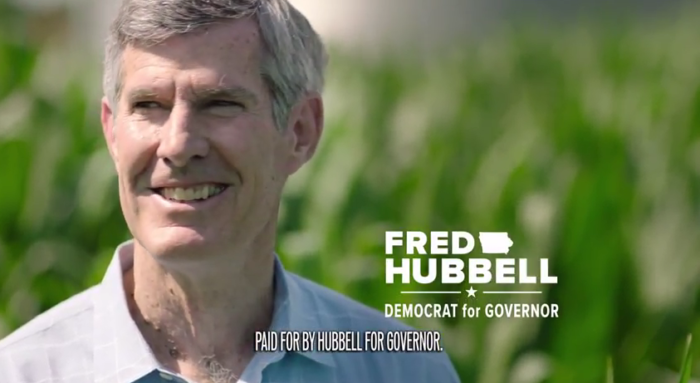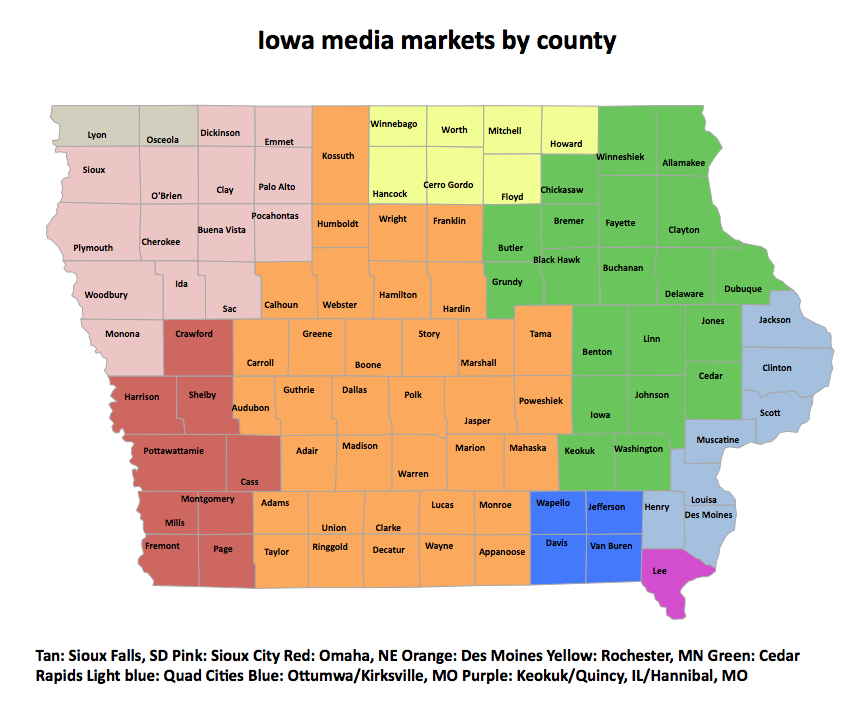Most Iowa politics watchers expected Fred Hubbell to win the Democratic nomination for governor last Tuesday. But the scale of his victory surprised many. How did Hubbell gain more than 55 percent of the vote and carry 96 of 99 counties against several other well-qualified candidates?
Hubbell’s unprecedented spending before an Iowa primary made him much better-known than the other five Democrats on the ballot. Television advertising was the campaign’s most costly investment: sixteen different commercials aired on stations reaching at least two-thirds of Iowa’s population, beginning last October.
The county-level results suggest that while Hubbell could have become the nominee without such saturation, tv ads helped him win a majority rather than merely a plurality among primary voters.
HUBBELL’S INVESTMENT IN TV AND DIRECT MAIL
Hubbell’s campaign spent close to $7 million before the primary (details are here and here). That figure exceeds expenditures by all other Iowa Democratic candidates for governor combined and more than doubles what Terry Branstad spent to win the GOP nomination for governor in 2010. Iowa’s last Democratic candidate for governor, Jack Hatch, spent about $1.8 million during the entire 2014 cycle. This year’s nominee has nearly quadrupled Hatch’s spending with five months to go before the November election.
Television and mail were Hubbell’s most important means of communication with Democratic voters. Yes, thousands of activists heard him speak at one or more large party gatherings, and hundreds attended one of the smaller events his staff organized during his travel to all 99 counties. But most of the 176,700 Iowans who cast ballots in the Democratic governor’s race did not personally interact with Hubbell during the past year. What they knew about him and the other contenders came largely from news reports or advertising.
Hubbell’s campaign spent more than $3.5 million on television ads alone.* He started running spots on Des Moines and Cedar Rapids broadcast stations in mid-October 2017. Except for a few weeks during the holiday season, Hubbell stayed on the air almost continuously in those markets, which reach a potential audience of more than 2 million people.
About three months before the primary, the campaign added cable to its Des Moines and Cedar Rapids buys and began advertising on broadcast stations in the Quad Cities and Sioux City markets. (On the expenditure report filed last month, the payments shift in early March from eight to 40 tv stations.) About 350,000 Iowans live in counties reached by Quad City stations, and 300,000 can watch Sioux City-based stations.
All told, roughly two-thirds of Iowans live in counties where Hubbell was up on tv for seven months before the primary. About 90 percent live in counties where the front-runner was on the air for three months. Not all voters watch television, of course, let alone the local newscasts where political spots are most prevalent. But many people are regular viewers, especially among the older age cohorts that dominate Iowa’s primary electorate.
Hubbell’s mail program reached Democrats in all 99 counties at a cost of more than $900,000.** About two dozen glossy mailers featured the candidate’s stance or past charitable work related to issues including education, Planned Parenthood, mental health, Medicaid, and the state budget. The target audience appears to have been voters who had participated in past Democratic primaries or caucuses. I reached out to a number of contacts in counties where local tv stations didn’t carry any Iowa political advertising this year. All confirmed receipt of many pieces promoting Hubbell. A “boat-load,” one resident of a northern-tier county told me. “Oodles and oodles and oodles of mailers,” said an activist in southwest Iowa.
HUBBELL’S PERFORMANCE IN TV VS NON-TV COUNTIES
I created this map of Iowa media markets based on information from the Dish User site.
Hubbell’s ads ran for seven months in the orange and green counties and for about three months in the pink and light blue counties. His campaign didn’t buy any television air time in Sioux Falls (tan), Omaha (red), Rochester (yellow), Ottumwa/Kirksville (blue), or Keokuk/Quincy/Hannibal (purple).
Now look at the nominee’s vote share by county.
The winner received less than 30 percent of the vote in just three counties (white on this map), all in southwest Iowa where people watch Omaha-based stations. Montgomery County is a special case, since it contains John Norris’s home town of Red Oak.
Hubbell received between 30 and 40 percent of the vote in six counties (yellow on this map). Two are in the Omaha market, two are in Sioux Falls, and one is in Ottumwa/Kirksville (though admittedly, Jefferson County has an unusual political culture and often votes differently from other small Iowa counties). Only one county where Hubbell polled below 40 percent was in an area reached by his tv ads: Louisa, where Nate Boulton grew up in Columbus Junction.
Hubbell received between 40 percent and 50 percent of the vote in fourteen counties (green on this map). He wasn’t on the air in ten of them. The remaining four were unusual in other respects. The population centers of Johnson and Winneshiek (Iowa City and Decorah) are college towns where many progressives were drawn to Cathy Glasson or Norris. Muscatine was among Glasson’s strongest counties. Norris owned and operated a business in the Adair County seat for years as a young man.
Of the 32 counties where Hubbell’s vote share fell between 50 and 60 percent, only five (Mitchell, Floyd, Hancock, Davis, and Wapello) were counties where his tv ads were not in rotation.
Hubbell won more than 60 percent of the vote in 44 counties, all in markets where he’d been advertising since at least March. In most of them, he’d been on tv since October.
Some Iowa pundits have commented that Hubbell won convincingly in every part of the state–rural as well as urban areas. That’s undeniable. Based on his showing where voters were exposed to his mail but not tv ads, he probably could have cleared the 35 percent threshold without spending a dime on television.
But it’s unlikely Hubbell could have surpassed 50 percent or even come close without saturating the air waves.
IMPACT OF HUBBELL’S ADVERTISING ON THE GENERAL ELECTION
Looking ahead to Hubbell’s prospects against Governor Kim Reynolds, the challenger already has a higher profile than if he had been on the air for a short time in fewer markets. Name recognition is typically a big advantage for incumbents. Reynolds is still better-known to Iowans, but she’s not as far ahead on that front as she could be.
More important, heavy spending on well-produced commercials allowed Hubbell to introduce himself before the inevitable barrage of Republican attacks. Thousands of viewers have seen him washing the dishes with Charlotte Hubbell, his wife of more than 40 years. They’ve heard him explain why he’s running for governor and promise to reverse the disastrous privatization of Medicaid. They’ve seen a former employee say, “Fred has had an amazing level of empathy and support for people in all different walks of life.” They’ve heard a testimonial from a boy dealing with mental health issues and his mother.
What may be Iowa’s most striking political ad this cycle was a 90-second spot about the Hubbells’ ordeal as hostages in Afghanistan and Syria in 1981. I wasn’t sure where they were going with the concept when that ad appeared last month, but I get it after seeing the nominee on Iowa Public TV’s “Iowa Press” this weekend:
[O.Kay] Henderson: Your opponent, Kim Reynolds, on primary night said essentially you are so rich that you’ve never known that it’s like to be not rich and that you have never had to balance the family checkbook because of the Hubbell name. How are you going to respond to her constant I guess message to voters that she comes from the working class and you come from the upper class and shouldn’t be elected?
Hubbell: Well, first of all, she can attack me all she wants. My wife and I have had a lot tougher experiences than that. And so that doesn’t bother me a bit.
The commercials focusing on Hubbell’s charitable giving to support mental health services, Planned Parenthood clinics, and other causes could be a mixed bag. On the one hand, they show the candidate has been generous and civic-minded. On the other hand, they reinforce the GOP’s preferred frame for this election: “Prince Frederick Hubbell” is a super-rich guy. Reynolds is a small-town girl, a former waitress and grocery checker who worked nights and finished her college degree later in life.
Democrats should not assume advertising will be as effective for Hubbell in the coming months as it was before the primary. The front-runner had the airwaves to himself for weeks at a time during the fall, winter, and spring. His less well-funded Democratic rivals were on tv intermittently, and only in Des Moines and Cedar Rapids. In contrast, Reynolds has the cash on hand to keep spending six figures on television every week.
Any comments about the governor’s race are welcome in this thread.
End notes:
* I calculated that Hubbell’s campaign spent $3,534,581.72 on television advertising by adding all expenditures to AL Media listed as “Ad Production” or “TV Ad Buy” on the January, mid-May, and pre-primary campaign disclosure reports. Using the search function on the Iowa Ethics and Campaign Disclosure Board’s website, I generated a list of disbursements to AL Media (part 1 and part 2) for those who want to see the expenditures in one place. Note: that list includes several smaller payments to the vendor for radio advertising, online advertising, or travel reimbursement, which I didn’t include when arriving at the $3.5 million figure.
** I calculated $933,191 in spending on direct mail by summing up payments to AMS Communications, Inc. for “Production, Printing and Shipping” from Hubbell’s January, mid-May, and pre-primary campaign disclosure reports. For those who want to view those expenditures in one document, here’s a separate list (part 1 and part 2).
Top image: Screen shot from “Steady,” the last of sixteen television commercials Fred Hubbell’s campaign ran before the June 5 primary.




2 Comments
Money wins again
I’m disappointed that Hubbell beat out John Norris whom I believed to be the better candidate, proving that money wins over ability.
There should be a limit on the amount of spending a candidate can do.
Christine Zook Mon 11 Jun 10:41 AM
The role of money
I didn’t vote for Hubbell. But now that he has won, I deeply hope he’ll win again in November. He would be so much better than Reynolds.
I strongly favor campaign finance reform. But of course the problem of money in Iowa politics goes far beyond that.
I noticed on IOWA PRESS recently that Hubbell said, in regard to water quality, that “the Nutrient Reduction Strategy is a good strategy going forward.” It is not. The Strategy is laughable. It has no standards, timelines, requirements, benchmarks, statewide plan, or systematic water testing. It’s a facade that ensures Iowa farmers don’t have to do anything. .
Meanwhile, the Chesapeake Bay strategy, which requires farmers to take action, is cleaning up the Bay. Researchers are finding cleaner water, more fish, and more seagrass. By contrast, the Gulf dead zone has been growing, while Iowans are told to be happy because some survey shows more farmers are starting to think about water.
The fact that no Iowa candidate can safely point out that the Strategy emperor has no clothes, let alone talk about the Chesapeake, is an example of the biggest problem of big money in Iowa politics. It turns truth-telling into political suicide so candidates won’t even attempt it.
PrairieFan Mon 11 Jun 3:03 PM